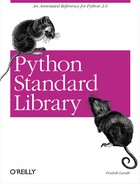Colophon
Our look is the result of reader comments, our own experimentation, and feedback from distribution channels. Distinctive covers complement our distinctive approach to technical topics, breathing personality and life into potentially dry subjects.
The animals on the cover of Python Standard Library are harvest mice. Many species of harvest mice populate North American grasslands and marshes, while only one species-Micromys minutus, the Old World harvest mouse-resides in the grasslands and farmlands of Europe and Asia.
Smaller than the common house mouse, the harvest mouse sports prominent ears and a very long hairy tail, and its hind feet have an opposable fifth toe for grasping and climbing stems. Behaviorally, harvest mice set themselves apart from other mice species by building breeding nests suspended in high grasses. These nests are baseball-sized globes of woven grass with small entrance holes and are lined with soft plant material, such as dandelion fluff, to keep the young warm. The young are born in litters of three to six, completely dependent on the mother (the father is not allowed in the nest). By the time they are five weeks old, however, they are independent and sexually mature. Overall, harvest mice typically live for six to eighteen months in the wild-enough time for a female to produce one to six litters in her lifetime. These numbers are much higher for mice in captivity.
The harvest mouse is a “cover dependent” species, as it relies on brush and vegetation to hide its small, brown body from predators as it forages for seeds and insect larvae. It moves slowly and adopts a still “camouflage posture” as further defense; overall, it is much more calm than the common house mouse.
The Western, Eastern, and Fulvous harvest mice (Reithrodontomys megalotis, Reithrodontomys humulis, and Reithrodontomys fulvescens, respectively) currently populate various regions of the United States and Canada with relative success, challenged somewhat by habitat loss due to crop farming, cattle grazing, and urbanization. However, their cousin the Saltmarsh harvest mouse (Reithrodontomys raviventris) suffers severe threat due to the filling in of its dwindling marshland home in the San Francisco Bay Area. The only endangered harvest mouse species, its members number in only the hundreds to the few thousands.
Catherine Morris was the production editor and proofreader, and Linley Dolby was the copyeditor for Python Standard Library. Emily Quill, Matt Hutchinson, and Claire Cloutier provided quality control. Joe Wizda wrote the index. Interior composition was done by Gabe Weiss, Matt Hutchinson, and Catherine Morris.
Hanna Dyer designed the cover of this book, based on a series design by Edie Freedman. The cover image is a 19th-century engraving from the Dover Pictorial Archive. Emma Colby produced the cover layout with Quark™XPress 4.1 using Adobe’s ITC Garamond font. Emma Colby also designed the CD label.
David Futato designed the interior layout based on a series design by Nancy Priest. The print version of this book was created by translating the DocBook SGML markup of its source files into a set of gtroff macros using a filter developed at O’Reilly & Associates by Norman Walsh. Steve Talbott designed and wrote the underlying macro set on the basis of the GNU troff -gs macros; Lenny Muellner adapted them to SGML and implemented the book design. The GNU groff text formatter Version 1.11.1 was used to generate PostScript output. The text and heading fonts are ITC Garamond Light and Garamond Book; the code font is Constant Willison. This colophon was written by Sarah Jane Shangraw.
The online edition of this book was created by the Safari production group (John Chodacki, Becki Maisch, and Madeleine Newell) using a set of Frame-to-XML conversion and cleanup tools written and maintained by Erik Ray, Benn Salter, John Chodacki, and Jeff Liggett.
